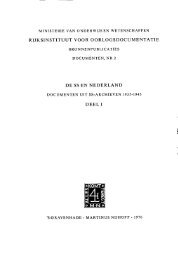De razzia van Rotterdam. 10-11 november 1944 - KNAW
De razzia van Rotterdam. 10-11 november 1944 - KNAW
De razzia van Rotterdam. 10-11 november 1944 - KNAW
Create successful ePaper yourself
Turn your PDF publications into a flip-book with our unique Google optimized e-Paper software.
262 SUMMARY<br />
The following objects must be taken along:<br />
warm clothing, heavy boots, blankets, a raincoat, cutlery and bread for one day. Bicycles<br />
will remain in the possession o f their owner.<br />
The daily compensation will consist o f good food, tobacco and five guilders.<br />
Members o f the family who are left behind will be taken care of.<br />
All inhabitants of the town are forbidden to leave their domicile.<br />
Those trying to escape or who offer resistance will be shot.<br />
As a result of this order about 40.000 inhabitants of <strong>Rotterdam</strong> and Schiedam 1<br />
were taken to Germany and about <strong>10</strong>.000 to the eastern part of the Netherlands.<br />
In carrying out the research the first thing to be investigated was how the <strong>razzia</strong><br />
had been prepared and organized by the Germans. Was it carried out according to a<br />
fixed scheme or haphazardly? How did the Germans succeed in controlling the men<br />
they had captured as long as they were in <strong>Rotterdam</strong>? What measures were taken<br />
against the population left behind during the time the arrested men were still in town?<br />
In order to understand the way in which the population of <strong>Rotterdam</strong> reacted to<br />
the measures taken a detailed investigation had to be made of how the men and<br />
women behaved at the time of the carrying out of the <strong>razzia</strong>. How did they show their<br />
surprise? How did they first learn of the <strong>razzia</strong>? What rumours were circulating in<br />
those parts of the town where the Germans had not yet appeared? What arguments<br />
decided the men to report or to go into hiding? What were the arguments used by<br />
their parents or by other members of the family? How did the population behave<br />
while the men were marched out of their streets? How can one account for the power-<br />
lessness of the men of <strong>Rotterdam</strong> after they had been assembled first in small, later<br />
in large numbers? Were there no possibilities of escape either during the march to<br />
the assembly areas or out of the town?<br />
These events and problems could not be studied in isolation. They had to be seen<br />
against the background of the military and economic situation of the German Reich<br />
and of the development of <strong>Rotterdam</strong> in the preceding years of war.<br />
Specifically investigation revolved round whether there was any connection between<br />
the <strong>Rotterdam</strong> <strong>razzia</strong> and the measures taken by the Germans in the course of the<br />
war in order to make Dutch manpower available to the German war economy. In<br />
August <strong>1944</strong> the Germans had suffered a heavy defeat in France. The part which<br />
had been allotted to the Netherlands resistance movement in view of the liberation<br />
of the Netherlands, was also made a subject of investigation.<br />
The program of research was extended to the transport of the men who had been<br />
arrested to the eastern part of Holland and to Germany and to the reaction of the<br />
Netherlands population in the towns they passed. Another point to be investigated<br />
was how social and economic life in <strong>Rotterdam</strong> was disorganised after the <strong>razzia</strong>.<br />
In doing so it was diflicult to isolate the factor of the general deterioration of living<br />
1 In the rest of the summary “<strong>Rotterdam</strong>” will be used to indicate both <strong>Rotterdam</strong> and Schiedam.






